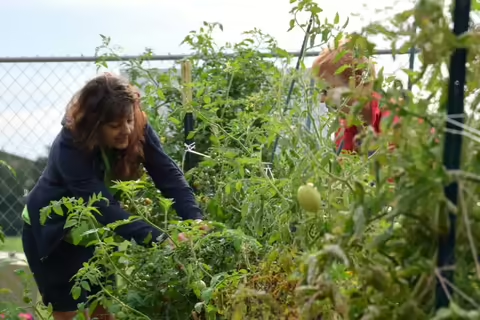URBANA, Ill. – As summer comes to an end, many vegetable gardeners are busy reaping what they’ve sown and harvesting the fruits of their labors. Growing your own vegetables has health, nutritional, and environmental benefits, says University of Illinois Extension Educator Nicole Flowers-Kimmerle.
The health benefits are exponential with the combination of nutrients, sunshine, and exercise gained through gardening. Walking, bending, lifting, and pulling movements that naturally happen in the garden fit into the moderate excise category that can increase your body's immune system function.
Certain vegetables, such as broccoli, cabbage, and brussels sprouts, produce a disease-fighting compound called sulfurane after being cut. Colorful vegetables provide antioxidants such as lycopene and beta carotene. Eating a diverse group of vegetables ensures balanced nutrition.
“Different varieties of vegetables have different flavors,” Flowers-Kimmerle says. “Growing your own vegetables from seed allows you to choose varieties for your garden to suit your tastes.”
The flavor is also based on biochemical changes that happen to the produce once it is harvested. "The sugar in sweet corn kernels starts converting to starch as soon as the ear is harvested," Flowers-Kimmerle says. “Cook sweet corn as soon as you can for the sweetest flavor.”
Harvest timing can also affect the flavor of a vegetable. Harvesting vegetables at their peak ensures maximum flavor. Locally grown vegetables benefit the environment by reducing carbon emissions from burning fossil fuels to transport grocery store produce.
“No plastic packaging is required when you harvest vegetables straight from the garden, which also reduces fossil fuel inputs,” Flowers-Kimmerle says. Pesticide and other chemical inputs tend to be lower in small, well-tended gardens than even small farms.
When vegetable gardeners use kitchen and yard waste as compost, they keep it out of landfills and create their own soil amendment to increase the garden's productivity.
These health and environmental benefits can last even longer with cool weather plantings for a late fall harvest. Vegetables that grow well in cool weather, such as leaf lettuce, radish, spinach, and turnips, can be planted throughout August. Visit the Illinois Extension website Vegetable Garden Guide at web.extension.illinois.edu/vegguide for planting dates. For more information on how to start a fall vegetable garden, contact your county Illinois Extension office or visit extension.illinois.edu.
SOURCE: Nicole Flowers-Kimmerle, Horticulture Educator, Illinois Extension
ABOUT EXTENSION: Illinois Extension leads public outreach for University of Illinois by translating research into action plans that allow Illinois families, businesses, and community leaders to solve problems, make informed decisions, and adapt to changes and opportunities.
PHOTO ACCESS: The photo in this article is available to download for media use.
